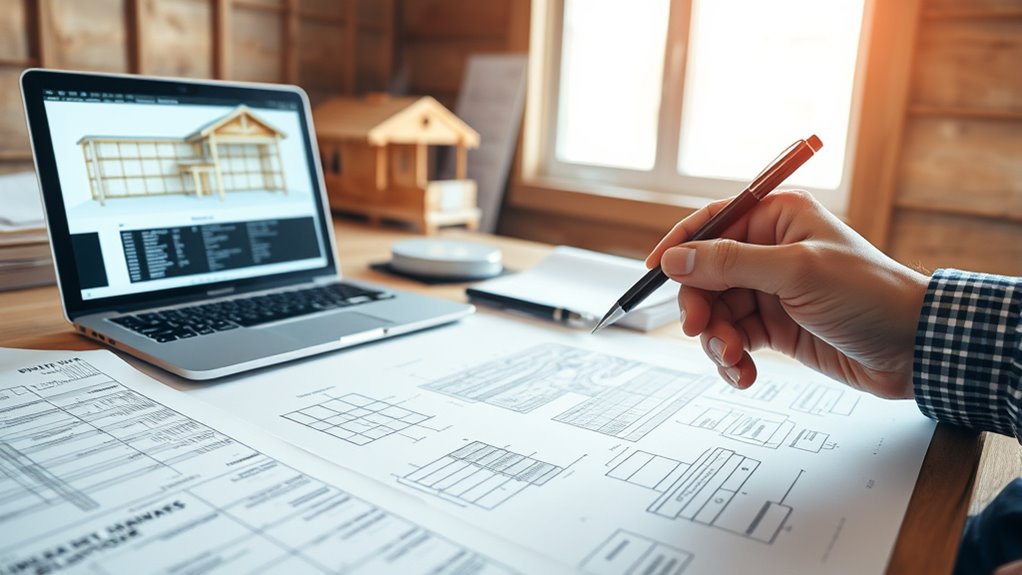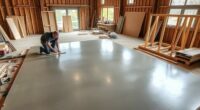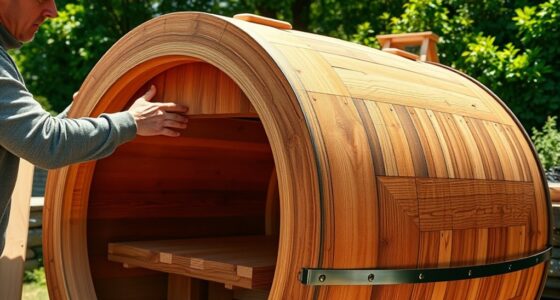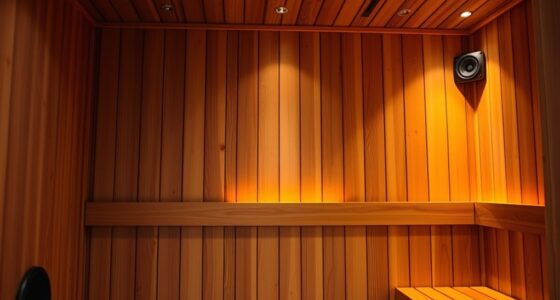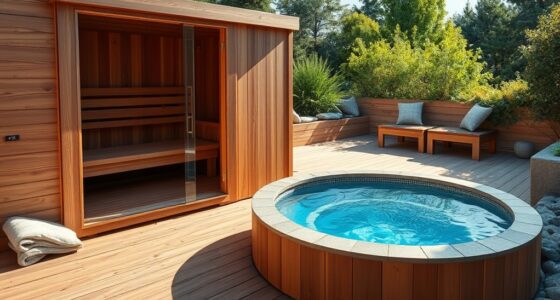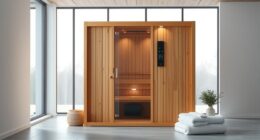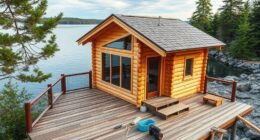To understand local building codes and permit requirements for sauna construction, you need to research your area’s specific rules. These codes ensure your project is safe, legal, and secure for everyone. You’ll need permits before starting and inspections during construction to verify electrical, ventilation, and fire safety. Knowing these regulations early helps you avoid fines or demolition. Stay with us to discover how to navigate these rules smoothly and keep your project compliant.
Key Takeaways
- Building codes ensure sauna safety, legal compliance, and protect residents from fire, electrical, and structural hazards.
- Permits are required before construction to verify adherence to electrical, ventilation, and fire safety standards.
- Inspections confirm compliance with local regulations and prevent costly fines or demolition.
- Zoning restrictions like setbacks, size, and noise limits influence sauna placement and design.
- Following local codes and permits ensures a safe, legal, and long-lasting sauna that maintains property value.
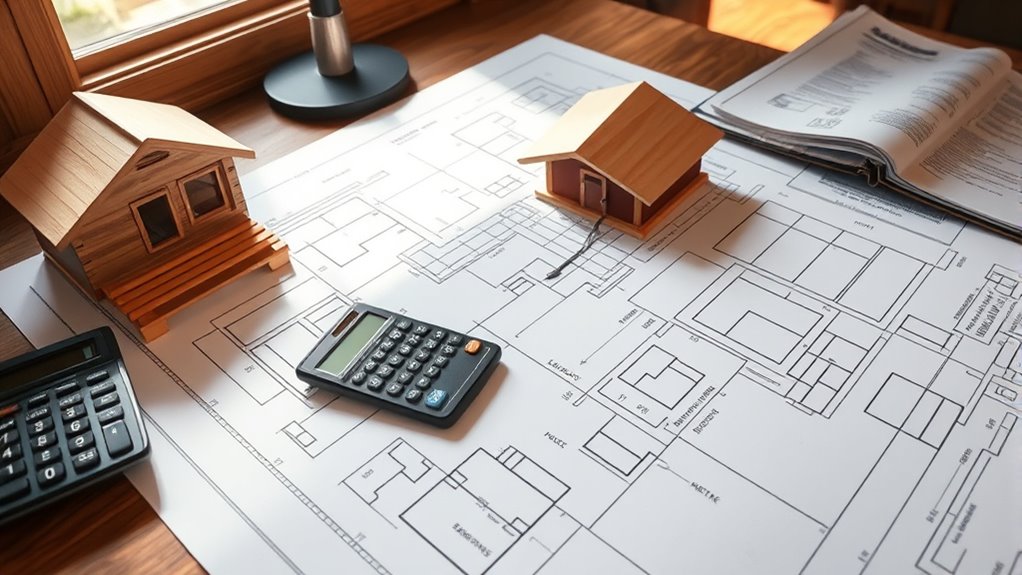
Have you ever wondered why local building codes are so important when planning a construction project? When you’re thinking about building a sauna, understanding these codes becomes essential to make certain your project meets safety and legal standards. Local building codes are designed to protect residents and property, and they include specific requirements for sauna safety to prevent accidents like fires or electrical hazards. Ignoring these regulations can lead to costly fines, delays, or even having to tear down your completed sauna. Additionally, zoning restrictions play a significant role in whether you can build a sauna on your property. Zoning laws determine where structures can be placed, their size, and their purpose, so knowing these restrictions helps you avoid conflicts with local ordinances.
Understanding local building codes ensures your sauna project is safe, legal, and compliant with regulations.
Before you start any construction, it’s imperative to research your area’s specific building codes and zoning restrictions. Many local governments require permits for building a sauna, especially because it’s a structure that involves electrical work and potential fire hazards. Securing the proper permit not only makes certain your project complies with local laws but also provides an opportunity for inspections that verify your sauna is safe to use. These inspections look at factors like electrical wiring, ventilation, and fire safety measures—elements that directly relate to sauna safety. If you overlook these requirements, you risk having to dismantle or modify your sauna later, which can be costly and frustrating. Understanding building regulations is also crucial for ensuring your sauna design aligns with safety standards.
Zoning restrictions often specify how close your sauna can be to property lines, whether it can be built in certain zones, or if there are height and size limitations. For example, in some areas, building a sauna too close to a neighbor’s property might violate setback rules, leading to disputes or legal issues. Understanding these restrictions early helps you plan your construction accordingly, saving time and avoiding violations. Many municipalities also have rules about noise levels or the use of certain materials, all of which can impact your sauna project.
In essence, respecting local building codes and zoning restrictions makes certain your sauna is safe, legal, and compliant. It’s a step that might seem tedious at first, but it’s essential for peace of mind and long-term satisfaction with your project. Taking the time to understand and follow these regulations helps you avoid unnecessary complications, makes certain your sauna is built safely for everyone’s use, and keeps your property within legal boundaries. So, before breaking ground, do your homework—review the rules, get the necessary permits, and plan your sauna project accordingly.
Frequently Asked Questions
How Often Do Local Building Codes Change Regarding Saunas?
Building codes for saunas typically change every few years, often aligned with broader building code updates. You should stay informed about local building code updates by checking with your city or county authorities. Permit renewal processes may be required if codes change during your project, so plan accordingly. Regularly reviewing these updates guarantees your sauna remains compliant and safe, avoiding potential fines or delays in your construction timeline.
Are There Specific Safety Standards for Sauna Electrical Wiring?
Think of electrical wiring standards as the backbone of sauna safety. You must follow strict electrical safety guidelines to prevent hazards. Local codes typically specify that wiring for saunas needs to be weatherproof, properly insulated, and installed with GFCI protection. Always make certain your wiring meets national and local standards, and consult a licensed electrician. This way, your sauna remains a relaxing retreat, not a risky venture.
What Are the Penalties for Non-Compliance With Local Permits?
If you violate permit requirements, you risk permit violations that could lead to hefty legal penalties. Local authorities can issue fines, require you to undo work, or halt your project altogether. In serious cases, you might face court actions or additional fines. To avoid these issues, always guarantee you obtain the necessary permits before starting your sauna construction and follow all local regulations diligently.
Do Building Codes Vary for Indoor Versus Outdoor Saunas?
Think of your sauna as a delicate garden that needs tailored care. Indoor saunas often follow stricter building codes, emphasizing sauna insulation and ventilation standards to prevent humidity damage. Outdoor saunas might have more relaxed rules but still require proper insulation against the elements. You need to check local regulations, because these codes guide how you build, ensuring safety and longevity regardless of where your sauna stands.
How Can I Verify if My Sauna Design Meets Zoning Requirements?
You can verify if your sauna design meets zoning requirements by checking your local zoning restrictions and setback requirements. Visit your city or county’s building department website, or contact them directly, to review specific regulations for your property. Make sure your sauna’s location respects setback distances from property lines and adheres to any zoning restrictions on structure size or use. This helps make certain your sauna project complies with local rules.
Conclusion
So, while you might think building your dream sauna is just about selecting the right wood and heater, don’t forget the fun part—navigating local codes. Ironically, the very rules meant to keep you safe can turn your relaxing project into a bureaucratic maze. But hey, if you enjoy a good puzzle, diving into permits might just be your new favorite pastime. After all, who needs instant relaxation when you can have a thrilling adventure in compliance?
